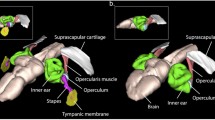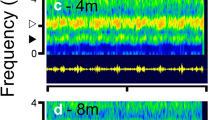Summary
-
1.
The sympatric, genetically compatible treefrogs,Hyla chrysoscelis andH. femoralis, were artificially crossed (reciprocally) and the F1 hybrid progeny raised to sexual maturity in the laboratory. The calls of males and selective phonotaxis of females were studied.
-
2.
Male hybrids began calling about seven months after the cross was made. The temporal properties of the vocalizations were intermediate, more similar to one or the other of the calls of the parental species, or unique to hybrids. Pulse period (pulse-repetition rate) was the most stereotyped temporal property and was more similar to that in the calls ofH. femoralis thanH. chrysoscelis. Dominant frequency of the calls of hybrids and both parental species was typically between 2 and 3 kHz.
-
3.
In two-stimulus playback experiments, F1 female hybrids were selectively attracted to hybrid calls in preference to those ofH. chrysoscelis. Females did not prefer hybrid calls over those ofH. femoralis, probably because of an overlap in pulse period and a significant difference in the total amount of acoustic stimulation. When these factors were eliminated or reduced by presentation of synthetic calls, female hybrids chose a stimulus with a pulse period typical of hybrids in preference to a call with a pulse period typical ofH. femoralis.
-
4.
There were no differences in the call structure nor in the selective phonotaxis of F1 hybrids of the reciprocal crosses, thus indicating that sex-link-age and maternal effects are probably not involved in the genetic specification of the acoustic communication system.
-
5.
The behavioral coupling (with respect to pulse period) demonstrated in this study and in crickets is consistent with the predictions of the ‘genetic coupling’ hypothesis, which postulates that both signal generating and recognition mechanisms share common circuitry specified by the same genes. The results of these behavioral studies are sufficiently encouraging to warrant neurophysiological, anatomical and genetic experiments that can provide direct tests of the hypothesis.
Similar content being viewed by others
Abbreviations
- C.V. :
-
coefficient of variation
- PN :
-
number of pulses per call
- PP :
-
pulse period
- PR :
-
pulse repetition rate
- SPP :
-
subpulse periods
References
Alexander RD (1962) Evolutionary change in cricket acoustical communication. Evolution 16:443–467
Bentley DR, Hoy RR (1972) Genetic control of the neuronal network generating cricket song patterns. Anim Behav 17:478–492
Bull CM (1978) The position and stability of a hybrid zone between the western Australian frogs,Ranidella insignifera andRanidella pseudinsignifera. Aust J Zool 26:305–322
Burger JA (1980) The effects of acoustic experience on the calls of gray treefrogs. M.A. thesis, University of Missouri, Columbia
Doherty JA (1982) Acoustic communication in interspecific hybrids between the gray treefrog,Hyla chrysoscelis, and the pinewoods treefrog,Hyla femoralis (Anura:Hylidae). PhD Dissertation, University of Missouri, Columbia
Doherty JA, Gerhardt HC (1983) Hybrid treefrogs: vocalizations of males and selective phonotaxis of females. Science 220:1078–1080
Doherty JA, Huber F (1983) Temperature effects on acoustic communication in the cricketGryllus bimaculatus DeGeer. Verb Dtsch Zool Ges 1983:188
Elsner N, Popov PA (1978) Neurethology of acoustic communication. Adv Insect Physiol 13:229–335
Ewing AS (1969) The genetic basis of sound production inDrosophila pseudoobscura andD. persimilis. Anim Behav 17:555–560
Ewing AS, Manning A (1967) The evolution and genetics of insect behavior. Annu Rev Entomol 12:471–494
Forester DC (1975) Mating call as a reproductive isolating mechanism betweenScaphiopus bombifrons andScaphiopus hammondi. Copeia 1973:60–67
Gerhardt HC (1970) Selected aspects of the reproductive biology of some southeastern United States hylid frogs. PhD Dissertation, University of Texas at Austin
Gerhardt HC (1974a) The vocalizations of some hybrid treefrogs: acoustic and behavioural analyses. Behaviour 49:130–151
Gerhardt HC (1974b) Mating call differences between eastern and western populations of the treefrog,Hyla chrysoscelis. Copeia 1974:534–536
Gerhardt HC (1974c) The significance of some spectral features in mating call recognition in the green treefrog (Hyla cinerea). J Exp Biol 61:229–242
Gerhardt HC (1978) Temperature coupling in the vocal communication system of the gray tree frog,Hyla versicolor. Science 199:992–994
Gerhardt HC (1982) Sound pattern recognition in some North American treefrogs (Anura: Hylidae): implications for mate choice. Am Zool 22:581–595
Gerhardt HC, Guttman SI, Karlin AA (1980) Natural hybrids betweenHyla cinerea andHyla gratiosa: morphology, vocalizations, and electrophoretic analysis. Copeia 1980:577–584
Helversen D von, Helversen O von (1975a) Verhaltensgenetische Untersuchungen am akustischen Kommunikationssystem der Feldheuschrecken. I. Der Gesang von Artbastarden zwischenChorthippus biguttulus andChorthippus mollis. J Comp Physiol 104:273–299
Helversen D von, Helversen O von (1975b) Verhaltensgenetische Untersuchungen am akustischen Kommunikations system der Feldheuschrecken. II. Das Lautschema von Artbastarden zwischenChorthippus biguttulus undChorthippus mollis. J Comp Physiol 104:301–323
Helversen O von (1979) Angeborenes Erkennen akustischer Schlüsselreize. Verh Dtsch Zool Ges 1979:42–59
Helversen O von, Helversen D von (1981) Korrespondenz zwischen Gesang und auslösendem Schema bei Feldheuschrecken. Nova Acta Leopoldina 54:337–344
Hoy RR (1974) Genetic control of acoustic behavior in crickets. Am Zool 14:1067–1080
Hoy RR (1978) Acoustic communication in crickets: a model system for the study of feature detection. Fed Proc 37:2316–2323
Hoy RR, Paul RC (1973) Genetic control of song specificity in crickets. Science 180:82–84
Hoy RR, Hahn J, Paul RC (1977) Hybrid cricket auditory behavior: evidence for genetic coupling in animal communication. Science 195:82–83
Hoy RR, Pollack GS, Moiseff A (1982) Species recognition in the field cricket,Teleogryllus oceanicus: behavioral and neural mechanisms. Am Zool 22:597–607
Loftus-Hills JJ (1973) Comparative aspects of auditory function in Australian anurans. Aust J Zool 21:353–367
Martin WF (1971) Mechanics of sound production in toads of the genusBufo: passive elements. J Exp Zool 176:273–294
Martin WF (1972) Evolution of vocalization in the genusBufo. In: Blair WF (ed) Evolution in the genusBufo. University of Texas Press, Austin, pp 279–309
McGrath TS, Shalter MD, Schleidt WM, Sarvella P (1972) Analysis of distress calls of chicken x pheasant hybrids. Nature 237:47–48
Mecham JS (1965) Genetic relationships and reproductive isolation in southeastern frogs of the generaPseudacris andHyla. Am Midl Natur 74:269–308
Pollack GS, Hoy RR (1979) Temporal pattern as a cue for species-specific calling song recognition in crickets. Science 204:429–432
Pyburn WF (1960) Hybridization betweenHyla versicolor andHyla femoralis. Copeia 1960:55–56
Schilcher F von, Manning A (1975) Courtship song and mating speed in hybrids betweenDrosophila melanogaster andDrosophila simulans. Behav Genet 5:395–404
Schneider H, Eichelberg H (1974) The mating calls of hybrids of the fire-bellied toad and yellow-bellied toad (Bombina bombina andBombina v. variegata). Oecologia 16:61–71
Walker TJ (1957) Specificity in the response of female tree crickets (Orthoptera, Gryllidae, Oecanthinae) to calling songs of the males. Ann Entomol Soc Am 50:626–636
Zweifel RG (1968) Effects of temperature, body size and hybridization on mating calls of toads,Bufo a. americanus andBufo woodhousei fowleri. Copeia 1968:269–285
Author information
Authors and Affiliations
Rights and permissions
About this article
Cite this article
Doherty, J.A., Gerhardt, H.C. Acoustic communication in hybrid treefrogs: sound production by males and selective phonotaxis by females. J. Comp. Physiol. 154, 319–330 (1984). https://doi.org/10.1007/BF00605231
Accepted:
Issue Date:
DOI: https://doi.org/10.1007/BF00605231




